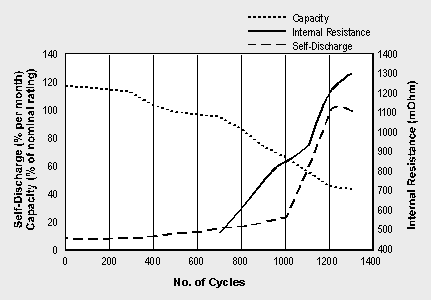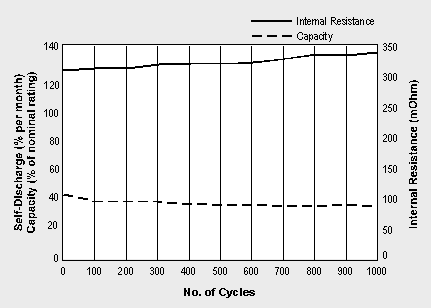<< Previous page INDEX Next page >>
The NiMH Battery — Figure 8-3 examines the NiMH, a battery that offers high energy density at reasonably low cost. We observe good performance at first but past the 300-cycle mark, the performance starts to drift downwards rapidly. One can detect a swift increase in internal resistance and self-discharge after cycle count 700.
Figure 8-3: Characteristics of a NiMH battery.
This battery offers good performance at first but past the 300-cycle mark, the capacity, internal resistance and self-discharge start to deteriorate rapidly. This illustrations shows results for a 6V, 950mA NiMH.The Li-ion Battery — The Li-ion battery offers advantages that neither the NiCd nor NiMH can match. In Figure 8-4 we examine the capacity and internal resistance of a typical Li-ion. A gentle capacity drop is observed over 1000 cycles and the internal resistance increases only slightly. Because of low readings, self-discharge was omitted for this test.
The better than expected performance of this test battery may be due to the fact that the test did not include aging. The lab test was completed in about 200 days. A busy user may charge the battery once every 24 hours. With such a user pattern, 500 cycles would represent close to two years of normal use and the effects of aging would become apparent.
Manufacturers of commercial Li-ion batteries specify a cycle count of 500. At that stage, the battery capacity would drop from 100 to 80 percent. If operated at 40°C (104°F) rather than at room temperature, the same battery would only deliver about 300 cycles.
Figure 8-4: Characteristics of a Li-ion battery.
The above-average performance of this battery may be due to the fact that the test did not include aging. This illustration shows results for a 3.6V, 500mA Li-ion battery.

